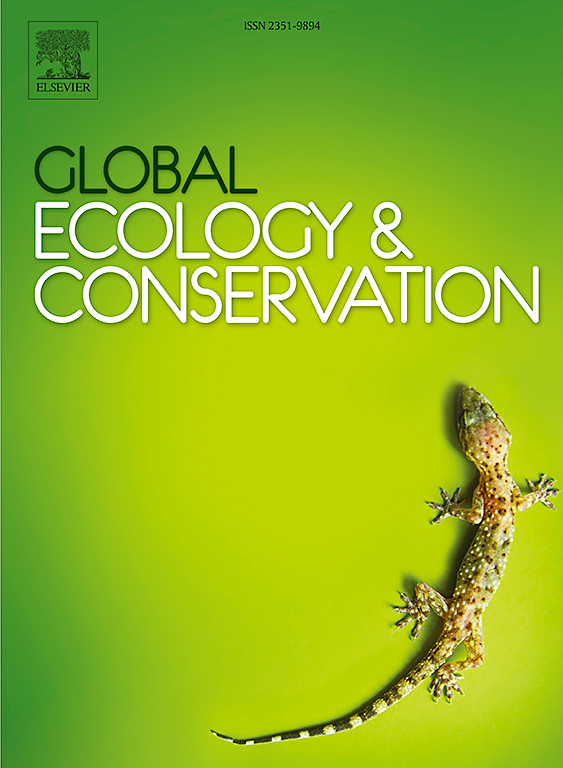人工池塘不支持高山龙和豆娘群落的自然功能和分类组成
IF 3.4
2区 环境科学与生态学
Q1 BIODIVERSITY CONSERVATION
引用次数: 0
摘要
高山地区拥有多样化的栖息地和丰富的生物多样性。然而,对许多濒危高山物种至关重要的水生环境在整个阿尔卑斯山的保护中代表性不足。在众多因素中,人类活动影响高寒水生生态系统。虽然人工池塘被提议用于支持生物多样性,但它们对天然高山淡水生物群的适用性尚不清楚。蜻蜓和豆娘具有异温生理和半水生生命周期,受到温度和生境特征的极大限制,因此在高寒人工水域中可能面临加性约束。本研究对41个不同海拔的人工水体和自然水体中的水蜥群落进行了调查,分析了水蜥的丰度、多样性及其与体温调节(体型和颜色亮度)、生活史(voltinism)和生境偏好(嗜热性和生境宽度)相关的特征。温度对蜻蜓和豆豆蝇群落的体温调节相关性状的影响不同,随着温度的降低(即海拔的升高),蜻蜓的体型增大,颜色亮度降低,而豆豆蝇的颜色亮度增加。与此同时,豆娘的丰度在寒冷的温度下急剧下降。两个亚目的嗜热性和生境宽度均随温度的降低而降低,但在人类活动地点这种趋势不明显。蜻蜓的性状变化遵循热黑变和伯格曼法则预测的趋势,而豆娘没有这种趋势表明有限的温度调节潜力。在全球气候变暖和生物多样性下降的背景下,高寒生境中温度和人为干扰的加性约束阻碍了高寒物种对这些水体的利用,挑战了高寒物种的自然保护潜力。本文章由计算机程序翻译,如有差异,请以英文原文为准。
Artificial ponds do not support the natural functional and taxonomic composition of alpine dragon- and damselfly communities
Alpine regions host diverse habitats and rich biodiversity. Yet, aquatic environments, crucial for many threatened alpine species, are underrepresented in conservation throughout the Alps. Among many factors, anthropogenization impacts alpine aquatic ecosystems. While anthropogenic ponds are proposed for biodiversity support, their suitability for the natural alpine freshwater biota remains unclear. Dragonflies and damselflies, with their ectothermic physiology and semi-aquatic life cycle, are greatly constrained by both temperature and habitat features, thus potentially facing additive constraints in alpine artificial waters. This study investigated Odonata communities in artificial and natural water bodies at 41 different elevations, analyzing abundance, diversity and traits associated with thermoregulation (body size and color lightness), life history (voltinism) and habitat preference (thermophily and habitat breadth). Temperature differently affected traits related to thermoregulation in dragonfly and damselfly communities, with an increase in body size and decrease in color lightness along decreasing temperature (i.e. increasing elevation) in dragonflies and an increase in color lightness in damselflies. Concurringly, damselfly abundances strongly decreased towards cold temperatures. In both suborders thermophily and habitat breadth decreased with decreasing temperature, but these trends were less pronounced in anthropogenic sites. Trait variation of dragonflies follows trends predicted by thermal melanism and Bergmann’s rule, while the absence of such trends in damselflies suggest limited thermoregulatory potential. The additive constraints of temperature and anthropogenic disturbance in alpine anthropogenic sites prevent alpine species to utilize such water bodies and challenges their potential for nature conservation in the face of global warming and biodiversity decline.
求助全文
通过发布文献求助,成功后即可免费获取论文全文。
去求助
来源期刊

Global Ecology and Conservation
Agricultural and Biological Sciences-Ecology, Evolution, Behavior and Systematics
CiteScore
8.10
自引率
5.00%
发文量
346
审稿时长
83 days
期刊介绍:
Global Ecology and Conservation is a peer-reviewed, open-access journal covering all sub-disciplines of ecological and conservation science: from theory to practice, from molecules to ecosystems, from regional to global. The fields covered include: organismal, population, community, and ecosystem ecology; physiological, evolutionary, and behavioral ecology; and conservation science.
 求助内容:
求助内容: 应助结果提醒方式:
应助结果提醒方式:


